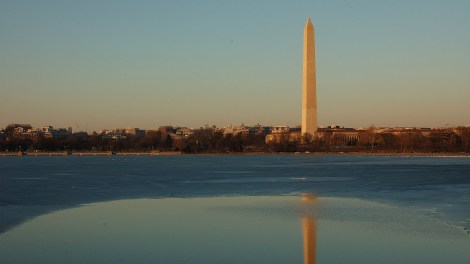
ShutterstockJust imagine the Washington Monument were a fracking rig …
Could we soon be seeing flammable water coming out of the White House taps? The federal government is considering allowing hydraulic fracturing near the Potomac River’s headwaters, which could make the dark side of fracking all too real for an administration and Congress that have been gung-ho for natural gas exploration.
George Washington National Forest, straddling the border of Virginia and West Virginia, is home to the hills where the Potomac, Shenandoah, and James rivers start forming. This watershed is the source of drinking water for 4 million people in greater Washington, D.C. It also sits above part of the Marcellus Shale, a massive store of natural gas.
In 2011, the U.S. Forest Service, which oversees GW National Forest, proposed banning fracking in it, as part of its next 15-year management plan. The fossil fuel industry and its flunkies in public office such as Virginia’s then-Gov. Bob McDonnell (R) criticized the move. So the Forest Service has been reviewing its proposal and is expected to release a final plan shortly.

Pete Souza/The White HouseWatch what you drink, Joe.
Natural gas fracking operations may contaminate nearby water sources with methane. That’s why fracking in the region is opposed by the agencies responsible for overseeing the safety of D.C.-area drinking water: the Fairfax County Water Authority and the Army Corps of Engineers, which operates the Washington Aqueduct. The aqueduct’s general manager is worried enough about the prospect of fracking that he sent a letter to the Forest Service pointing out the obvious: “Safe water supply is essential to life.”
It’s not only safe drinking water in the nation’s capital that would be at risk. As The Washington Post reported last year, “One hundred species of fish and mussels live in the shallow waters of the Cowpasture and Jackson rivers, which gurgle in the forest along the Appalachian spine. There are also 70 types of amphibians and reptiles, 180 species of birds and 60 species of mammals. The list of all the trees, plants, fishing areas, hiking trails and campsites could fill a book.”
And damaging the environment could also hurt the local economy. The Los Angeles Times notes, “In Virginia, counties such as Augusta and Rockingham near George Washington National Forest boast some of the state’s richest agricultural land, and many towns benefit from tourism tied to the forest.”
The decision on fracking in the GW forest is coming just as environmentalist frustration with Obama’s “all of the above” energy policy has burst into public view. Last week, a coalition of leading environmental groups exchanged argumentative letters with the White House over President Obama’s enthusiasm for domestic dirty energy exploration. Environmentalists are worried that increased drilling on public lands and in the oceans will lead to environmental degradation and contribute to global warming. Ironically, in this case, one of the victims of the health, safety, and ecological effects of domestic drilling could be the president himself.



